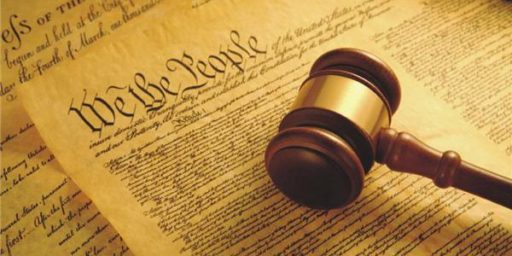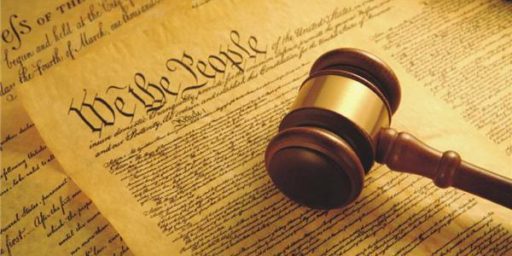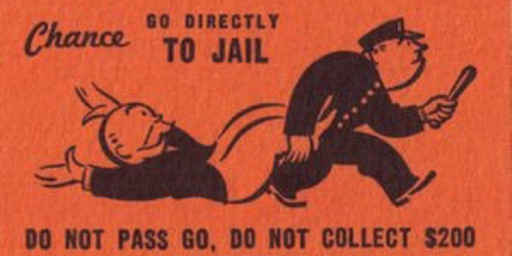Thoughts on the Voting Rights Act Case
One of the Supreme Court’s most anticipated decisions this term is likely to deal with the constitutionality of part of one of the landmark laws of the 20th century, the Voting Rights Act of 1965; this may be the most important of a series of cases the court will tackle this term considering civil rights. In this post, I’m going to try to dissect the case from a few perspectives; since it’s longer than the usual OTB fare, I’m going to put most of the post in the “extended entry section.”
A brief summary for the impatient: the Supreme Court is looking at a particular section of the Voting Rights Act, “Section 5,” which deals with preclearance, authorizing the Justice Department and the U.S. District Court for the District of Columbia to delay (and in some cases nullify) actions of state and local governments in certain parts of the United States that might have an adverse effect on voting rights. The Court is unlikely to strike down all of the Voting Rights Act, and may not even strike down all of Section 5, but I think it is likely that the Court will at least narrow the interpretation of the VRA to either (a) allow jurisdictions other than counties, states, and independent cities to “bail out” of Section 5 coverage or (b) restrict Section 5’s application to only elections to federal office, where Congress arguably has broader powers to regulate elections. In particular, the Court will almost certainly retain Section 2 of the VRA, a more general provision which provides for all of the relief authorized in Section 5 (except the preclearance procedure) but which applies nationwide. Finally, even if the Court strikes down Section 5, Congress would probably be within its powers to adopt a notification requirement that would in essence be a modified version of preclearance.
A necessary disclaimer: my expertise is in voting and Southern politics, not the intricate details of Voting Rights Act jurisprudence, and I am not a lawyer.
Background: Congress passed the Voting Rights Act of 1965 as the culmination of a series of civil rights laws beginning late in the Eisenhower administration and continuing through the Kennedy and Johnson years that gradually increased the role of Congress and the executive branch in enforcing voting rights, primarily among African Americans in the South. While the judiciary had been active in striking down some measures that discriminated against minorities, including the “white primary” laws and grandfather clauses, these acts had limited effect on improving black voter registration and participation rates in the South, where local election officials continued to be authorized to employ literacy and understanding tests and the poll tax to legally exclude “undesirable” persons from the voting rolls, and often employed these and other tools (such as limited registration windows designed to coincide with times when the working poor would be expected to be planting or harvesting) in a blatantly discriminatory way.
In response, Congress passed a number of civil rights bills, including the Civil Rights Acts of 1957, 1960, and 1964, which included authorizing the executive to exercise increased oversight of local election practices and limitations on the use of various devices such as the literacy test and poll taxes; the 1964 Civil Rights Act in particular legally mandated that completion of the 8th grade would be considered sufficient to prove “literacy” and abolished poll taxes in federal elections (the poll tax ban was made permanent in federal elections and extended to state and local elections by the 24th Amendment). However, these actions had a limited impact on the 1964 elections in the South, and continued attacks on civil rights protesters by white mobs (most notably in Selma in early 1965, a protest directed specifically at voting practices in Alabama’s black belt counties) led the Johnson Administration to propose a separate Voting Rights Act, which was debated by Congress that summer and passed into law.
For our purposes, the two key provisions of the VRA were Sections 2 and 5 of the law (Sections 3 and 8 are also significant in that they authorize the DoJ and the courts to monitor election practices in covered states, but the importance of these activities has diminished since the 1960s). Section 2 provides that private citizens and the DoJ can bring suit against any election practice that is discriminatory in either its intent or impact; this provision was made permanent in the 1982 renewal of the Voting Rights Act, and applies nationwide. Section 5, which is more controversial, applies only to certain “covered jurisdictions” defined by criteria in Section 4 of the original act and subsequent amendments; effectively, these areas are most (but not all) of the southern states, Alaska, Arizona, and certain counties and townships in North Carolina and a few other states outside the south.
The 1982 amendments also allowed covered jurisdictions to “bail out” of coverage; all of the jurisdictions that have done so thus far are counties and independent cities (which carry out the functions of counties as separate subdivisions of the state) in Virginia.
Constitutionality of the VRA: The Act as a whole, and Section 5 of the Act in particular, was controversial from the get-go. However, the Supreme Court in South Carolina v. Katzenbach (383 US 301) upheld the VRA, including Section 5’s provisions that “froze” election practices in covered jurisdictions until reviewed by the DoJ or D.C. Court, in an 8-1 ruling authored by Chief Justice Earl Warren. Warren argued that the VRA was a valid exercise of Congress’ enforcement powers granted by the 15th Amendment and that Section 5’s “uncommon exercise of congressional power” was justified because:
Congress knew that some of the States covered by 4 (b) of the Act had resorted to the extraordinary stratagem of contriving new rules of various kinds for the sole purpose of perpetuating voting discrimination in the face of adverse federal court decrees. [footnote omitted] Congress had reason to suppose that these States might try similar maneuvers in the future in order to evade the remedies for voting discrimination contained in the Act itself. Under the compulsion of these unique circumstances, Congress responded in a permissibly decisive manner.
In short, Congress had resorted to adopting Section 5 to combat attempts by the states and their subdivisions to employ what we might call a “Whac-a-Mole” strategy of filibustering efforts to enforce the VRA by replacing provisions declared unconstitutional with other, barely distinguishable provisions that more than likely would be no more constitutional but remain in effect until DoJ or other plaintiffs could challenge them in court.
The Case Before The Court: The case before the Supreme Court this term was filed by Northwest Austin Municipal Utility District Number One (NAMUNDO), which sounds like it would be a mediocre Latino boy band but is actually a political subdivision of the state of Texas that provides local utility services in suburban Travis County. NAMUNDO contends that it should be allowed to “bail out” of coverage as a “covered jurisdiction” even if Travis County remains covered (the county does not appear to have any interest in bailing out itself, and has filed a brief in opposition to NAMUNDO’s position); however, the Justice Department contends that only states and state subdivisions that register voters are eligible for the “bail out” provision of the VRA. NAMUNDO also argues that the Section 5 coverage formula is no longer constitutionally justified, as the extraordinary circumstances of “Whac-a-Mole” challenges to federal authority no longer exist and Section 2, along with the activities of the DoJ’s Civil Rights Division and various organized interest, is sufficient to deter formerly covered jurisdictions from attempts to limit minority voting rights in the future.
The Merits of the Case: My reading of the relevant laws and regulations suggests that the court could go either way on NAMUDNO’s “bail out” argument. The simplest ruling that would make most everyone happy would be to allow any subdivision that conducts elections to “bail out” of coverage; while NAMUDNO would probably take advantage of this provision if it could (it has spent plenty to litigate the case to this point), I am uncertain whether most cities, towns, villages, sewage districts etc. would be willing to expend the money to do so themselves for the convenience of avoiding preclearance. Given the Court’s current predilection for strict reading of statutes and Roberts’ efforts to make questions as narrow as possible, there’s a good chance the decision will simply grant NAMUDNO’s request on this point and not reach the constitutional argument.
If the Court were to reach Section 5 as a whole, I think there is a tougher question at work. If Section 2 did not also exist, it would be very difficult for the Court to strike down Section 5; however, the only advantage Section 5 offers over Section 2 is the “freezing” of existing laws and procedures prior to review. Given that most actions in covered jurisdictions these days are precleared with little controversy–and even controversial actions such as the mid-decade redistricting in Texas and Georgia’s voter ID law have been precleared only to face Section 2 challenges–there is a fair argument to be made that Section 5 is no longer narrowly tailored to accomplish the objective in question and represents an aberration in the relationship between federal and state authority. The enforcement powers granted to Congress by the various voting rights amendments (15th and 19th as of 1965, along with the 26th today) are broad, but not plenary, otherwise Congress would have had the authority to abolish poll taxes and extend the right to vote to 18-20 year olds in state and local elections without constitutional amendments.
There is also an argument to be made that Section 5, to remain constitutional, is not broad enough; arguably, the jurisdictions that historically discriminated against ethnic and linguistic minorities have made their peace with voting rights (and many are now majority-minority in nature, making it unlikely that their election officials will deny voting rights to fellow minority members). On the other hand, jurisdictions not covered by Section 5 have become more ethnically diverse due to further northward migration by Hispanics and increased immigration by Asian-Americans to regions other than the Pacific coast; it is possible that local officials might seek to marginalize votes by citizens from these groups in areas of the country that historically were ethnically homogeneous.
However, I do think Congress does have the power to impose something like preclearance on state and local actions that impact federal elections, per Article I, Section 4 of the constitution which allows Congress to “by Law make or alter” “[t]he Times, Places and Manner of holding Elections for Senators and Representatives.” The Court could thus argue that actions by political subdivisions that do not impact elections to Congress are not coverable by Section 5 of the VRA; NAMUDNO and other local subdivisions that only conduct elections with state or local impact independent of federal elections would thus be “bailed out” but Section 5 would remain intact for at least any election procedure that has implications for federal elections, including decisions by counties on polling place locations etc. in covered jurisdictions. For most elections that “matter” Section 5 would remain in effect, but this would effectively give NAMUDNO the relief it seeks without dismantling Section 5 in its entirety.
Even if Section 5 were to be struck down by the Supreme Court in its entirety, I believe Congress does have the authority (either directly or by tying the requirement to federal aid) to require states and other jurisdictions of its choosing to notify the federal government of any action that affects procedures for federal, state, and local elections in advance of their going into effect; while this would not have the automatic injunctive power associated with the current Section 5, the Civil Rights Division and/or any organized interest that monitored these notifications would have ample notice to request an injunction from a federal court under Section 2 (which applies nationwide and is permanent) of the VRA prior to the action becoming effective.
Last but not least, there is virtually no prospect of the entirety of the VRA being struck down; none of the litigants or amici have argued in favor of that position, and Section 2 in particular is clearly within Congress’ 15th Amendment power to enforce that amendment. Given the vibrant health of the organized interests that litigate in voting rights cases (as demonstrated by the number of amicus briefs from those organizations) even if Section 5 is struck down–something I think is relatively unlikely to happen–there are unlikely to be any notable adverse effects on minority voting rights as a result of this case, no matter the outcome.





